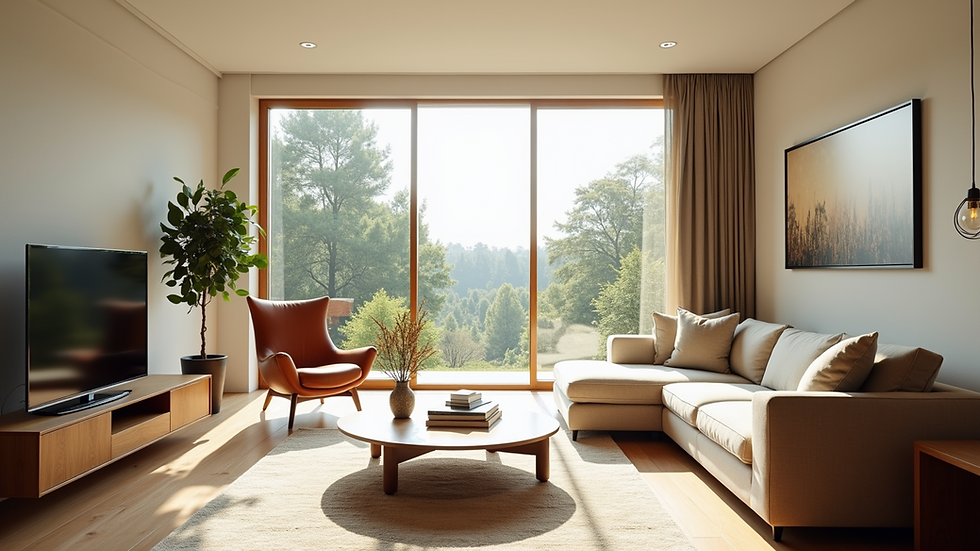Exploring the Evolution of American Interior Styles
- Jeff Parker
- Oct 7
- 3 min read
American interior styles have evolved dramatically over the centuries, reflecting the country’s rich cultural heritage, technological advancements, and changing lifestyles. From the early colonial days to modern minimalism, each era tells a unique story through its design choices. This blog post explores the fascinating journey of American design, highlighting key styles, influences, and practical tips for incorporating these timeless elements into your home.
The Roots of American Design: A Blend of Cultures and Practicality
American interior design began as a practical response to the needs of settlers and immigrants. Early homes were simple, functional, and built with locally available materials. The influence of European settlers, especially from England, France, and the Netherlands, shaped the initial styles. These designs emphasized durability and comfort, often featuring handcrafted wooden furniture, stone fireplaces, and muted color palettes.
As the country grew, so did its design identity. The Industrial Revolution introduced mass production, making furniture and decorative items more accessible. This period saw the rise of Victorian styles, characterized by ornate details, rich fabrics, and elaborate woodwork. The American middle class embraced these styles as symbols of prosperity and sophistication.

The Influence of American Design Movements on Interior Styles
American design has been shaped by several key movements that reflect the nation’s evolving tastes and values. The Arts and Crafts movement, for example, emerged as a reaction against industrialization, promoting handcrafted quality and natural materials. This style favored simplicity, exposed joinery, and earthy tones, which remain popular in rustic and farmhouse interiors today.
Mid-century modern design, which gained popularity in the mid-20th century, introduced clean lines, organic shapes, and innovative materials like molded plywood and fiberglass. This style emphasized functionality and minimalism, influencing contemporary interiors with its timeless appeal.
In recent decades, American design has embraced eclecticism, blending traditional and modern elements to create personalized spaces. Sustainable design and smart home technology are also shaping current trends, reflecting a growing awareness of environmental impact and convenience.

What is Early American Design?
Early American design refers to the styles prevalent during the colonial period and the early years of the United States. It is characterized by simplicity, practicality, and the use of natural materials. Furniture was often handmade from local woods like pine, oak, and cherry, featuring sturdy construction and minimal ornamentation.
Common elements include:
Windsor chairs with spindle backs
Four-poster beds with simple drapery
Handwoven textiles such as coverlets and rugs
Large hearths serving as the focal point of rooms
This style reflects the settlers’ need for functional living spaces that could withstand harsh conditions. Despite its simplicity, early American design has a timeless charm that continues to inspire modern rustic and farmhouse interiors.

Incorporating American Design Elements into Your Home
Whether you prefer the elegance of Victorian styles or the sleekness of mid-century modern, there are practical ways to bring American design into your living space. Here are some actionable recommendations:
Mix Old and New: Combine vintage furniture pieces with contemporary decor to create a balanced look.
Use Natural Materials: Incorporate wood, stone, and textiles that evoke warmth and authenticity.
Focus on Functionality: Choose furniture and layouts that prioritize comfort and usability.
Add Personal Touches: Display heirlooms, artwork, or handmade items that tell your story.
Embrace Neutral Palettes: Use soft, earthy colors as a base, then add pops of color through accessories.
By understanding the history and characteristics of American interior styles, you can create a home that feels both timeless and uniquely yours.
The Future of American Interior Design
As we look ahead, American interior design continues to evolve, influenced by global trends and technological innovations. Sustainability is becoming a central theme, with designers prioritizing eco-friendly materials and energy-efficient solutions. Smart home technology is seamlessly integrating into interiors, enhancing convenience without compromising style.
Moreover, the blending of cultures and the rise of personalized design mean that American interiors will become even more diverse and expressive. Whether through bold colors, mixed textures, or innovative layouts, the future of American design promises creativity and inclusivity.
For those interested in exploring more about the rich heritage of American interiors, resources on american design history offer valuable insights and inspiration.
Exploring the evolution of American interior styles reveals a dynamic story of adaptation, innovation, and cultural expression. By appreciating the past and embracing the future, you can create interiors that honor tradition while reflecting your personal style.


Comments